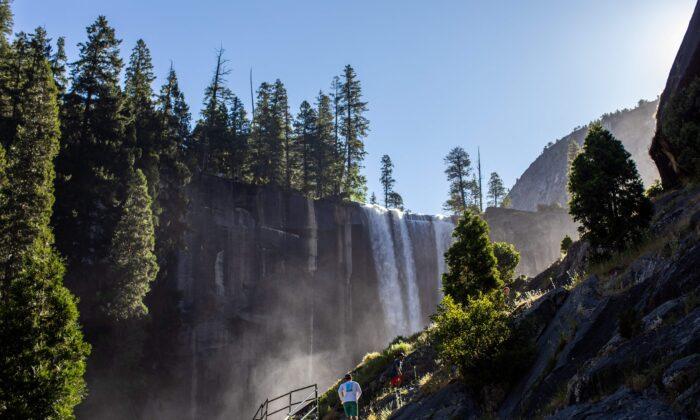California saw record levels of travel-related spending in 2023, according to a newly released report published by Visit California—a nonprofit organization promoting tourism in the Golden State—though when inflation is factored in, the totals lag pre-pandemic highs.
Spending totaled $150.4 billion last year and is forecast to hit $159.8 billion for 2024, according to the report.
Food service and accommodation industries led in dollar terms in 2023, with nearly $35 billion and $33 billion spent, respectively.
California Gov. Gavin Newsom celebrated the news by announcing the findings from the top of the Golden Gate Bridge on May 5.

“What a perfect place to announce our record-breaking tourism numbers,” Mr. Newsom said. “People coming back not only to visit but coming back to live as well.”
His office suggested the state has rebounded from the sharp decline in travel experienced during the COVID-19 pandemic.
According to the report, California’s tourism dollars accounted for 12.4 percent of travel spending nationwide.
“Travel spending in California has fully recovered from impacts by the pandemic,” a spokesperson for the governor’s office told The Epoch Times by email. “Tourism spending in the state is at a record high, and California continues to have the largest market share of tourism in the country.”
Titled “The Economic Impact of Travel in California” and prepared by Dean Runyan Associates, an analysis firm that compiled the data and wrote the report for Visit California, the study found that 2023 spending was 5.6 percent higher than spending in 2022—led by a 22 percent jump in travel within the state by residents—and was nearly 4 percent higher than its peak in 2019.
However, adjusted for inflation, spending remains 14 percent below record levels.
“Of course, an out-of-touch millionaire like Gavin Newsom would ignore the devastating inflation of the last three years,” Republican Minority Leader Assemblyman James Gallagher told The Epoch Times by email on May 6. “Regular Californians have been crushed by rising prices for everything from gas to groceries, but the governor won’t even admit there’s a problem.”
The governor’s office countered that such claims are missing the forward progress made by the state in recent years.
“Despite the near-immediate loss of 500,000 travel and hospitality jobs during the pandemic, California has bounced back as the [No. 1] state in the nation for tourism spending,” a spokesperson for Mr. Newsom told The Epoch Times by email on May 6. “People can try to undermine California’s success all they want, but the fact is tourists keep visiting the [fifth] largest economy on planet Earth because of all our state has to offer, and the data supports that.”


Although the state beat the national average of a 4 percent increase last year, it trailed the country’s 7 percent jump compared with 2019.
However, when accounting for inflation, spending nationwide increased slightly from pre-pandemic highs, while spending in California has not yet returned to peak levels.
Travel spending from international visitors totaled $24.3 billion last year, a 38 percent increase from 2022, yet fell 15 percent below that category’s peak in 2018, which the report blamed on a slow recovery regarding visitors from China and other countries in Asia following the pandemic.
The governor said the state’s natural beauty and tourist attractions are drawing travelers from across the world.
“From our world-renowned coastline to the world’s tallest trees, to our iconic cities and theme parks, California is the nation’s coming attraction,” Mr. Newsom said in a May 5 statement. “Visitors from all over the world are coming here to experience the wonder of the Golden State, boosting our economy, and creating good-paying jobs for years to come.”

Employment figures industrywide have nearly reached pre-pandemic totals and have almost doubled in the past four years—with nearly 1 million jobs added—according to the report.
Most counties saw increases last year, but some areas have yet to recover from 2019 levels. The San Francisco Bay Area, although it leads the state in terms of money spent at $37.1 billion and gains last year at 7.5 percent, remains 3.5 percent below its highs.
The top five travel regions—including the Bay Area, Los Angeles area, San Diego County, Orange County, and Central Coast—in the state grew in 2023 at an average rate of 6.9 percent, the report found.
Tourism activities generated nearly 65,000 new jobs in 2023, bringing employment across the industry to more than 1.1 million, according to the report.

Tourism-related state and local tax revenues combined increased by 3 percent from 2019 to about $12.7 billion, accounting for nearly $967 per household statewide.
State taxes—accounted for by lodging, sales, fuel, and business and personal taxes paid by employees and employers—increased by 2.7 percent from last year but remained 1.8 percent below 2019 highs.
That deficit is driven by a decline of nearly 10 percent in tourist-related taxes collected by the state compared with pre-pandemic totals, while business- and employer-related travel jumped by 23.1 percent over the same period, which indicates the industry is primarily being driven by job-related travel rather than that from visitors vacationing.
Local taxes—including sales and lodging fees imposed by cities, counties, and local tax jurisdictions—increased by 4.6 percent from 2023 and spiked by 7.5 percent compared with 2019, according to the report. The increase was led by a 19.2 percent jump in business and employee travel.
One segment of the industry that saw declines across the board was gas and transportation, which fell by 5.3 percent, with analysts pointing to a decrease in average fuel prices compared with 2022 as a primary factor as opposed to fewer miles traveled by visitors.
According to the report, it is expected the state’s tourism dollars will increase annually over the next five years, with spending potentially totaling $190.7 billion in 2028.







